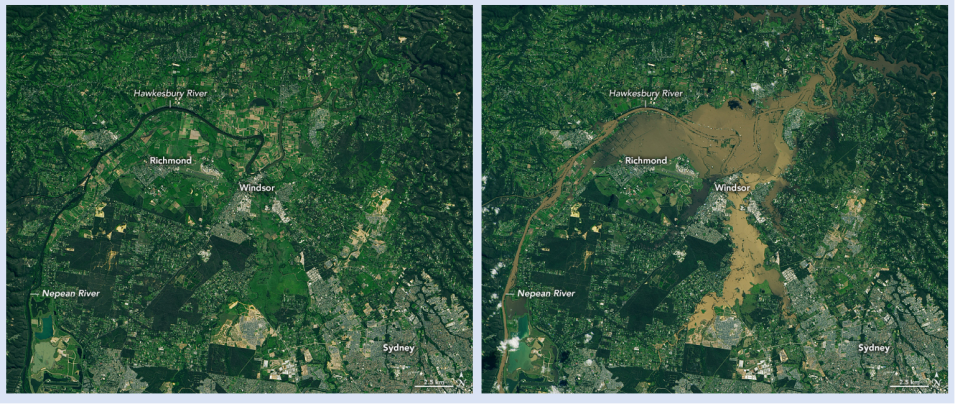Flooding events can have devastating consequences for people, ecosystems, and economies. Floods occur throughout the world, and a single major flood event can result in billions of dollars in damages. The hazards of operating ground-based equipment in flood zones and the limited physical access to flooded areas make it difficult to acquire information about flood extent on the ground. Accurately detecting floods and flood extent via remote means greatly aids in the process of mitigating and responding to these destructive events.
NASA's IMPACT Collaborates on Global Flood Detection Challenge
Before (left) and after (right) images showing the effect of persistent rain in March 2021 that led to historic flooding near Sydney, New South Wales, Australia. Both images were acquired by the Operational Land Imager (OLI) aboard the joint NASA/USGS Landsat-8 satellite and show the same region, with Sydney in the lower right corner. Left image: April 5, 2020. Right image: March 23, 2021. Click on image for larger view. Images: NASA Earth Observatory.
To help advance efforts to bring machine learning and artificial intelligence (AI) to the remote detection of floods, NASA’s Interagency Implementation and Advanced Concepts Team (IMPACT) is helping organize the Emerging Techniques in Computational Intelligence (ETCI) 2021 Competition on Flood Detection. The Institute of Electrical and Electronic Engineers (IEEE) Geoscience and Remote Sensing Society (GRSS) Earth Science Informatics Technical Committee (ESI TC) is joining IMPACT in coordinating this effort. The contest begins April 14 and takes place over two phases through July 1, when winners will be announced.
The challenge involves a supervised learning task – participants will develop algorithms to identify flood pixels after training their algorithm against a training set of synthetic aperture radar (SAR) images. Participants are required to submit binary classification maps, and performance of the submitted algorithms will be evaluated using the intersection over union (IOU) score, which is a popular evaluation metric for tasks such as segmentation, object detection, and tracking.
Dr. Manil Maskey, leader of the IMPACT Advanced Concepts Team, ESI TC chair, and one of the competition’s organizers, explains the reasoning behind the event:
We view data science challenge as a way to address the issue of scarcity of benchmark datasets to address problems with using AI within Earth science. Here, we are leveraging an open framework for community solution to benchmark curated training datasets for flood extent mapping, which allows us to maximize the potential use of Earth science data for advanced AI algorithm development and comparison.
IMPACT is a component of NASA’s Earth Science Data Systems (ESDS) Program, and works to further the ESDS goal of overseeing the lifecycle of Earth science data to maximize the scientific return of NASA’s missions and experiments for research as well as for applied scientists, decision makers, and society.
Examples of the training data used in the contest. Notice how the reference flood image (c) lines up with the flooded area in the two SAR images (a and b). The designations VV (Vertical Vertical) and VH (Vertical Horizontal) in the SAR images is an indication of the polarization of the imaging radar. NASA’s provision of the complete ESA (European Space Agency) Sentinel-1 SAR data archive through the ASF DAAC is by agreement between the U.S. State Department and the European Commission (EC). Image: NASA IMPACT.
Over the summer of 2020, IMPACT’s Machine Learning Team coordinated the work of students around the world labeling SAR datasets provided by NASA’s Alaska Satellite Facility Distributed Active Archive Center (ASF DAAC). ASF DAAC archives and distributes SAR data in NASA’s Earth Observing System Data and Information System (EOSDIS) collection.
The Disasters Team at NASA’s Marshall Space Flight Center in Huntsville, AL, collaborated with ASF DAAC through a grant from NASA’s Applied Sciences: Disasters Program to provide SAR imagery, subject matter expertise, and weekly guidance to students responsible for generating the flood extent datasets. These manually generated maps provide necessary ‘truth’ for validating NASA research and applications algorithms. These collaborative efforts across NASA programs and resulting data science competitions align with the IMPACT and ESDS goals of promoting open science.
IMPACT team member Shubhankar Gahlot, who also is the point of contact for the competition, explains one of the key goals of the event:
This challenge aims to promote innovation in the detection of flood events and water bodies, as well as to provide objective and fair comparisons among methods.
As noted above, the contest takes place in two phases. During Phase 1 (Development; April 14 to May 14), participants receive training data and validation data to train and validate their algorithms. Participants can submit prediction results for the validation set to the competition website to get feedback on their performance from April 15 to May 14, 2021. The performance results of the best submission from each participant account will be displayed on the leaderboard.
During Phase 2 (Test; May 15 to June 30), participants receive validation set reference data for model tuning and the test dataset to generate predictions and submit their binary classification maps in NumPy array format.
The first, second, third, and fourth-ranked teams in the competition will be declared winners on July 1, 2021. For complete rules and guidelines, along with registration instructions, please see the IMPACT 2021 ETCI Competition on Flooding Detection GitHub page.
Article originally published April 6, 2021 on the IMPACT blog and reprinted with permission.
More information and resources:

